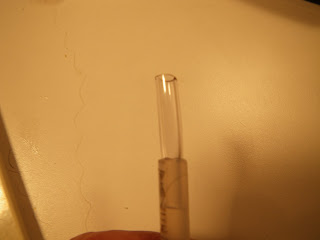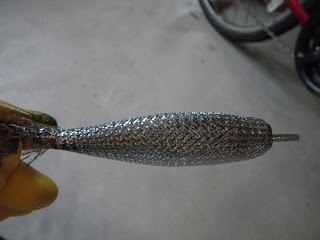Caller two is Robert, from Minnesota. Go ahead caller:
"Really enjoy your blog Mr. P. I like the stories and the information and I like your humor. I really enjoy your photography too. I love the one of the reel and the fish underwater. Sounds like you mostly fish clear water and can see the fish you're casting to. Your underwater pictures make it look that way also. Is that true? Around here our water is cloudy. There are Carp feeding and what I see is a bubble column rising up from where they are. I cast to the bubble columns and catch fish but usually the fish are snagged and haven't taken the fly. It sounds like the fish are taking your fly and you can see them take it. Wish we had that here. Do you fish any water that is cloudy? What flies do you feel work well in muddy conditions? Any thoughts on detecting takes when you can't see the fish? Thanks."
Thanks for the email Robert. Some of the water I fish varies in clarity a great deal. The Columbia River can be very clear one day, somewhat clear the next day, and have almost no visibility another day. There is an old saying, "The best time to go fishing is when you can." For me that means that sometimes I go when the conditions aren't the best and I just deal with it. When I know conditions are going to be bad sometimes I choose to not go and wait for a better day.
I say these next things cautiously and respectfully. I much prefer to fish in conditions where I can sight fish. I wrote in my fishing journal in the 80's that "the take is the premier moment." It was true then and it is even more true for me now. Hunting and stalking Carp is riveting. Seeing them take is such a rush. If you live somewher where all of the water is cloudy all of the time then there isn't much you can do about that except drive a long ways to find clear water.
I live in Western Washington. Going away the best Carp fishing is on the other side of the state. I drive a minimum of three hours to get to various spots on the Columbia. It is a five hour drive for me to get to Banks Lake. There is another lake in Eastern Washington that I chase Carp in. I have been there probably 25 or 30 times. Being in that part of the state makes things a minimum of 3 hours and often more. I just take for granted now that I have to drive to find Carp in clear, or somewhat clear water. I ask this question respectfully because I know it can be easier said than done. Are you able to drive to find Carp in clear water? I think it is worth the time.
Each of the last four years I have fished different, new water that was completely cloudy. I understand this to be what they call brownlining. All four times I would say that the spots truly had too many Carp. I had a couple guys ask me how I could say that a spot had too many Carp. My best example is from three years ago. I was fishing the Columbia one day and this guy pulled into the area I was parked. He was a PUD lineman and he stopped for lunch. When I am asked what I am fishing for sometimes I say, "whatever bites", and sometimes I say, "Carp". It just depends on how I think the conversation will go. When this guy asked I smiled and said, "Carp." He immediately answered and said, "Do you want to know the best Carp lake in the whole world?" Well of course I did so I said, "yes". Wow, think of it, the best Carp lake in the whole world, right here in Washington. He said that it was called Cougar Lake and that it was filled with Carp. He even gave me directions. I went there the next day. The lake was as he said, just teeming with fish. I caught 13 Carp. Okay, I have done that in the past but I had never caught 13 Carp in 13 casts before. But here's the thing, it wasn't any fun at all. Twelve of the thirteen fish were snagged. Only one of them had picked up the fly. The fish that had eaten the fly really wasn't any more fun to catch than the other ones because I really couldn't tell if he had taken the fly until he was very close to me. Two of the fish were snagged below their lip but that is still a snag. I don't really count snagged fish as caught fish but more to the point snagging them takes the joy out of it.
A few weeks later I went back to Cougar Lake one more time with my son. I wondered, as you do, if the patterns we used, or possibly the techniques we used would make any difference in the very cloudy water conditions.
We tried a variety of flies. Something we both observed is that we had fewer snags on small flies but that is not some big revelation. The color of the fly didn't seem to make a difference nor did the pattern we chose. We tried casting into the fish and letting the fly sit for three or four minutes before we stripped. We tried slow hand twists or very short twitches. We both got just one fish to take the fly. We both snagged several fish and as I said, that is just no fun at all. We both got our fish on Chocolate Cherry Carp Woollies. That was of some small note but I am not likely to return to Cougar Lake because it is too difficult to keep from snagging the fish.
Cougar Lake had zero visibility. None at all. In some cases we were able to cast to bubble columns just like you talked about, Robert. Because the water was so cloudy we really couldn't tell which way the fish was moving or even pointing. I knew my fly had to be close to the fish when I put in next to or even right on top of the bubble column but there was no way to reliably detect a take. We caught some of the fish that were creating the bubbles but they were snagged; they had not sucked up the fly.
These last four years my experience in the other locations with very muddy water was much the same. In conditions where the water is totally muddy I would say that the fly doesn't make a lot of difference and neither does technique. A guy or gal is going to snag the majority of the fish caught and I think it is darn difficult to keep from snagging them.
All of that said, I think it is quite a different thing to fish water that is somewhat cloudy and has at least a small amount of visibility. It is a whole "nuther" game. If you have some visiblility, even a small amount, and you can at least see which way the fish's mouth is pointing, then I would suggest, Carp Carrots, SJW's, and Chocolate Cherry Carp Woollies. In water that is very cloudy but still has some visibility sometimes I can get so close to the fish that I can literally hold out the rod and just set the fly in front of them. I don't even need to make an actual cast; I just sort of let it drop in front of the fish. This method is sometimes referred to as dapping. Even this small amount of visibility puts much of the joy back into chasing Carp. As to technique in these conditions, if I think I have cast or dapped the fly onto the "Carp's plate" then I will let the fly sit for awhile. I tend to let a SJW sit longer than a Carrot or other fly. Slow, short strips seem to be even more important in these kind of conditions.
I hope there is some clear, or at least somewhat clear water you can drive to Robert. I believe that you will just be dazzled by the difference in the experience.
Gerhard, I am working on answers to your questions; I will finish in the next several days.
P
Jon Hart CarpFest
4 months ago


































